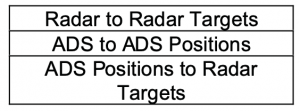34TH ANNUAL CONFERENCE, Jerusalem, Israel, 27-31 March 1995WP No. 106Fusion of ADS and Radar Data |
An application of ADS being actively pursued by ICAO’s CNS/ATM committee, and by industry, is to use ADS data to fill in gaps in radar coverage In addition such a situation will occur at the boundaries between ADS airspace and airspace where radar services are being provided. Such operating modes lead to specific operational requirements.
Fusion of ADS and radar data
An essential component of the CNS/ATM concept is the introduction into operational service of digital networks which can transmit data. ADS reports can be transmitted along these networks and made available to ATSU’s.
Experiments have been carried, out such as those by EUROCONTROL, the Italian CAA and Alenia near Brindisi, at utilising ADS data to provide a surveillance function in areas where radar coverage is not possible. The potential exists therefore to reduce the effect on system capacity of non-radar bottlenecks in areas where radar is not available.
A situation display can provide positions derived form radar data and ADS positions concurrently, thus fusing or integrating the two data sources onto one display. This situation can also occur at the boundaries of domestic en-route airspace and oceanic airspace where ADS is used. In these areas of transition, an increase in flexibility and capacity can potentially come.
Operational issues of the fusion of surveillance data
The inherent differences between surveillance conducted by radar and ADS mean that initially, it is unlikely that ADS separation standards will reduce to radar minima. However, it should be noted that where ADS data is used in conjunction with radar data in high density airspace, VHF radio communications may be available, thus separation minima maybe less than ADS operations. The principle ATC issue is the complexity of applying separation standards for two different types of position derived from differing surveillance mediums.
In these circumstances three separation standards may be envisaged between:

Where ADS is employed, the separation standards must be determined in accordance with an approved ICAO methodology. Attention must be given to the complexity and increases in controller workload that such a mode of operation can lead to. At all times it is essential that the derivation of position data displayed on the situation display must be shown to the controller in a prominent way so that the appropriate separation can be applied. There are potential gains to come where, in both types of airspace envisaged in this working paper, aircraft are tactically controlled using ADS and radar data with VHF RT communications.
Transition Areas
At airspace boundaries which embrace an ADS-ATC environment on one side, and a radar environment on the other side there are potential operational gains to the management of traffic flows by using data fusion of surveillance data. Such areas, however hold the prospect of significant confusion unless the airspace is structured so as to enable flexibility in ATC operations. Therefore where appropriate, transition areas should be established which facilitate the transition of air traffic from one environment to the other. The control units where such transition areas are established must be equipped with the appropriate inter-unit communications links, and have the system capability to interact within an ADS and a radar ATC environment.
To Conclude
The use of ADS offers significant operational benefits in areas where radar coverage is not available. In addition, at the boundaries of ADS airspace and radar controlled airspace, considerable tactical flexibility can come from fusing the surveillance data.
Such a controlling mode can lead to great complexity, thus the combinations must be limited to ensure the maintenance of flight safety. In order for the radar controller to safely separate traffic, the position data shown must show its source, and the necessary ADS system components be in place.
The control of air traffic across the juxtaposed boundaries of ADS and radar ATC equipped units will require the establishment of transition areas to enable flexibility in the control of air traffic and to reduce the complexity of the operational environment.
It is recommended that:
Control of traffic using position data derived from ADS and radar surveillance can only be used where the control system supports both types of surveillance and must be subject to a synchronised refresh rate.
The derivation of position data must be prominently displayed on the situation display continuously.
Separation standards to be applied between radar targets and ADS positions must be subjected to an ICAO approved collision risk analysis.
Transition areas should be established between radar and non-radar areas of responsibility.
The number of different separation standards available for use should be kept to a minimum. ATC should have the option to limit the number of separation standards in use at any time.
ATC will require the provision of assistance tools for managing airspace where multiple separation standards apply.


